Meal prep grocery list this simple tool completely transformed how I plan my week, shop for food, and stick to healthy habits. When I first started meal prepping, I often forgot key ingredients or wasted money on things I didn’t need. Everything changed once I created a clear, goal-focused meal prep grocery list.
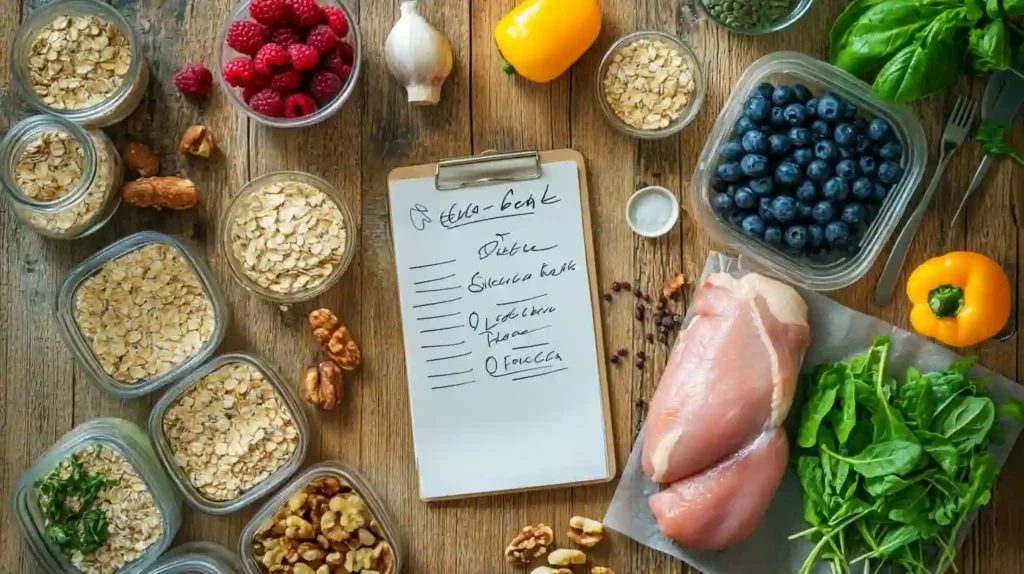
With the right list, I began building weekly meal plans that were both easy and affordable. It helped me stay on track with healthy eating and cut down on stress at the store. Whether you’re prepping for weight loss, clean eating, or just trying to save money, having a reliable grocery list for meal prep makes the process faster and more effective.
In this guide, I’ll share exactly how I do it.
Jump To
What to Include in a Meal Prep Grocery List
A meal prep grocery list should include lean proteins, fresh or frozen vegetables, whole grains, healthy fats, and meal prep staples like herbs, spices, and cooking oils. Don’t forget storage essentials like containers or zip bags to keep meals fresh and organized throughout the week.
I usually divide my list into core sections: proteins, grains, vegetables, fruits, dairy (or alternatives), and pantry staples. This simple format works whether I’m following an easy weekly meal plan or adjusting for a more specific goal like a bodybuilding meal prep grocery list or a budget-friendly meal prep grocery list. I also keep quick snacks and versatile ingredients on hand so I can switch things up midweek without scrambling.
What you include should reflect your actual weekly needs. A good meal prep grocery list isn’t one-size-fits-all it’s flexible enough to match your routine, preferences, and goals. The more intentional your list, the smoother your shopping and prepping will be.
Meal Prep Grocery List Template
Creating a clear and structured meal prep grocery list template has saved me time, money, and a lot of last-minute stress. Instead of guessing what to buy each week, I use this template as a reliable framework, that I can quickly adapt to any weekly meal plan I’m following whether it’s focused on healthy eating, weight loss, or just keeping things simple and budget-friendly.
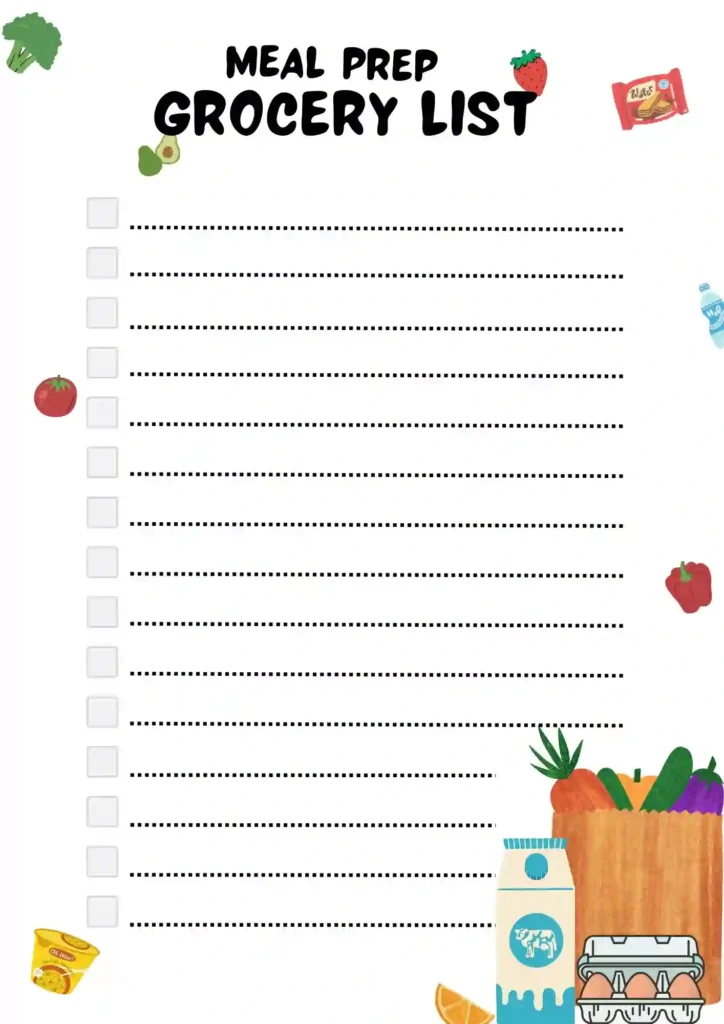
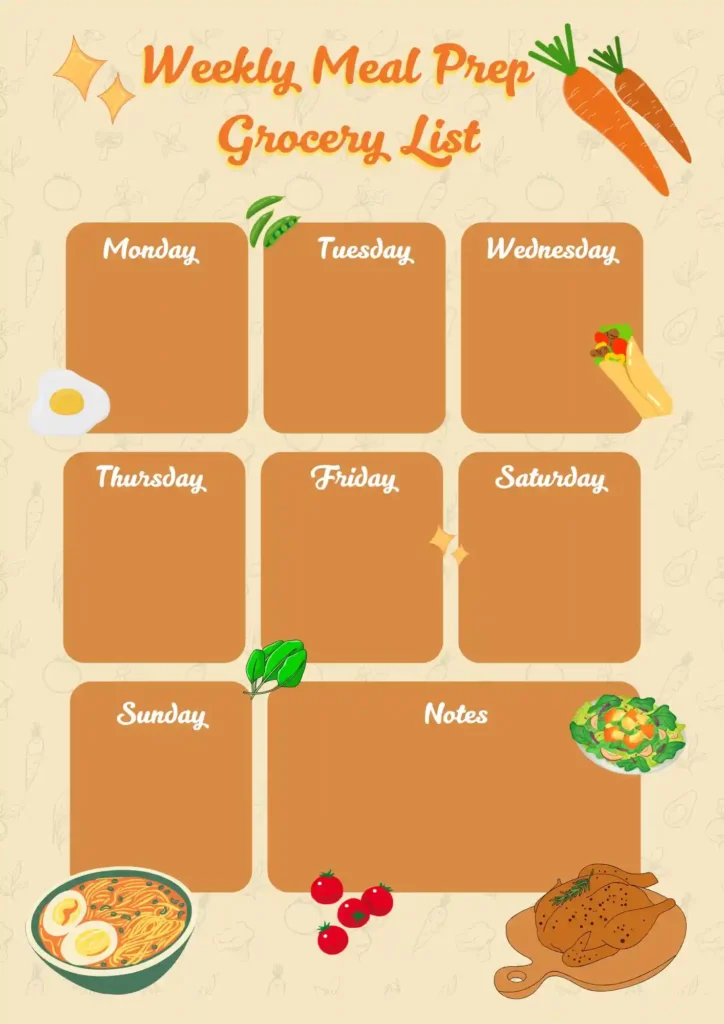
My template is broken down by food categories to make shopping fast and organized. It includes sections for proteins, whole grains, fresh produce, dairy or alternatives, pantry staples, and meal prep extras like sauces or condiments. Whether I’m building an easy weekly meal plan or following a strict meal plan with grocery list for fitness goals, this structure keeps everything on track.
If you’re looking for a basic meal prep grocery list, this template works as a perfect starting point. You can print it out, keep it on your phone, or duplicate it week after week. Having a go-to system like this helps eliminate the guesswork and supports a more consistent approach to meal prep no matter your lifestyle or budget.
Healthy Meal Prep Grocery List
A well-balanced healthy meal prep grocery list is the foundation of how I stay on track with clean eating during busy weeks. Instead of grabbing random “healthy” items, I focus on whole, nutrient-dense foods that support my energy, digestion, and long-term goals. Over time, this approach has helped me simplify planning while still enjoying variety in my meals.
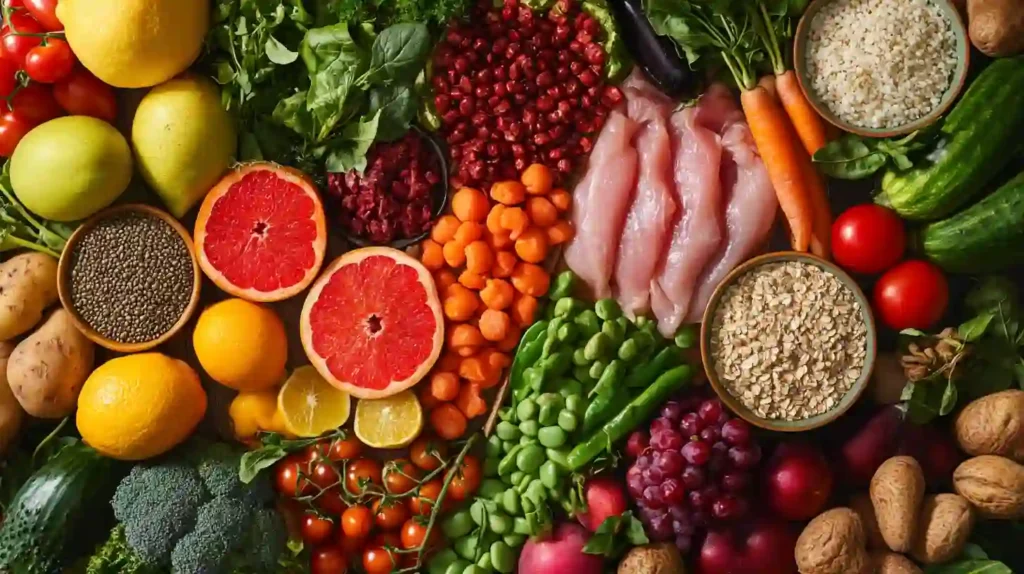
My list usually includes lean proteins like chicken breast, salmon, tofu, or eggs, along with fiber-rich vegetables such as broccoli, spinach, bell peppers, and carrots. I also add in whole grains like quinoa, brown rice, or oats, and healthy fats from items like avocados, nuts, or olive oil. For snacks and sides, I keep fruits like berries, apples, or bananas ready to go.
Here’s an example of a healthy meal prep grocery list I often use as part of my weekly meal plans:
Proteins:
- Chicken breast.
- Salmon fillets.
- Extra-firm tofu.
- Eggs or egg whites.
Vegetables:
- Broccoli.
- Spinach.
- Bell peppers.
- Zucchini.
- Carrots.
Grains & Legumes:
- Brown rice
- Quinoa
- Lentils
- Rolled oats
Fruits:
- Blueberries.
- Apples.
- Bananas.
- Oranges.
Healthy Fats:
- Avocados
- Almonds or walnuts
- Natural peanut butter
- Olive oil
Other Essentials:
- Greek yogurt
- Low-sodium broth
- Fresh herbs and spices
This simple but complete grocery list for meal prep makes it easy to stick to your goals, whether you’re planning for general wellness or following a more structured meal prep ideas for the week grocery list.
Meal Prep Grocery List for Weight Loss
When I first started focusing on weight loss, creating a realistic and structured meal prep grocery list for weight loss made all the difference. Instead of cutting calories randomly or buying trendy diet foods, I built my list around whole, low-calorie, high-volume ingredients that actually helped me feel full and satisfied.
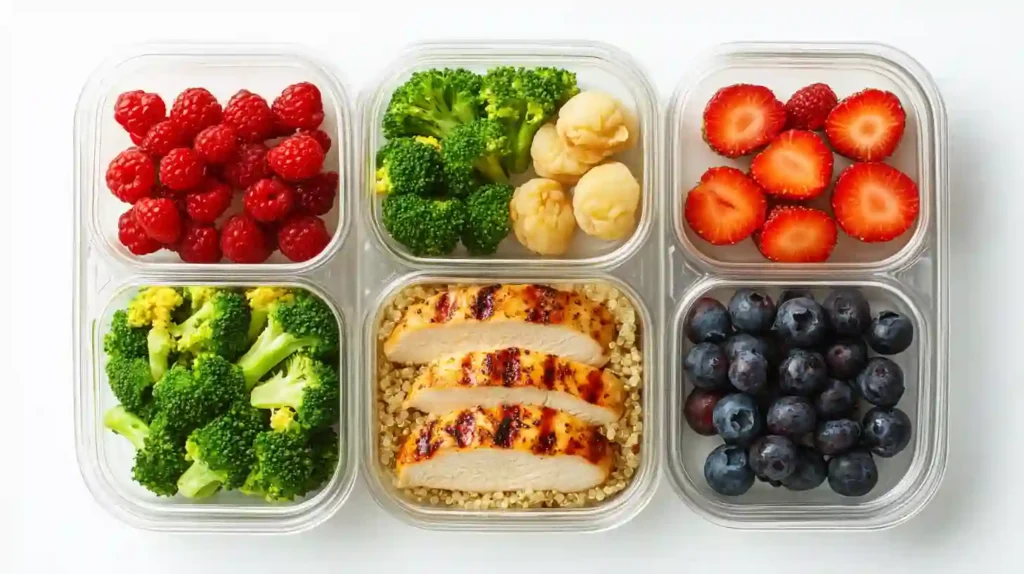
Here’s a sample weight loss-focused grocery list for meal prep that I use regularly:
Lean Proteins:
- Skinless chicken breast
- Ground turkey (93% lean or higher)
- Canned tuna in water
- Egg whites
Vegetables:
- Cauliflower
- Zucchini
- Kale
- Bell peppers
- Cucumbers
Smart Carbs:
- Sweet potatoes
- Brown rice (measured portions)
- Lentils
- Quinoa (in moderation)
Fruits (low-sugar):
- Strawberries
- Blackberries
- Green apples
- Grapefruit
Healthy Fats:
- Avocados (½ per serving)
- Chia seeds
- Raw almonds (pre-portioned)
- Olive oil (for cooking only)
Other Essentials:
- Fat-free Greek yogurt
- Low-sodium canned beans
- Sugar-free almond milk
- Fresh herbs, lemon, garlic, and spices
This type of meal prep for weight loss grocery list works because it keeps my weekly meals low in calories but high in nutrients and flavor. It also fits easily into an easy weekly meal plan and supports consistency which, in my experience, is the real key to long-term weight loss success.
Meal Prep Grocery List for a Week
Planning a full week of meals doesn’t have to be overwhelming. I’ve found that using a meal prep grocery list for a week, broken down by day, helps me stay organized and makes shopping incredibly efficient. Instead of guessing what to eat or cook, I follow this day-by-day structure to prep everything I need in advance and it fits easily into any weekly food planner routine.
Below is a sample 7-day meal prep grocery list organized by day. You can mix and match meals or adjust based on your preferences:
Monday
- Chicken breast.
- Broccoli.
- Brown rice.
- Olive oil.
- Garlic powder.
Tuesday
- Ground turkey.
- Sweet potatoes.
- Green beans.
- Cumin.
- Salsa.
Wednesday
- Canned tuna.
- Whole grain pasta.
- Cherry tomatoes.
- Spinach.
- Lemon.
Thursday
- Eggs.
- Bell peppers.
- Onions.
- Whole wheat wraps.
- Cheddar cheese.
Friday
- Shrimp.
- Zucchini.
- Couscous.
- Chili flakes.
- Fresh parsley.
Saturday
- Black beans.
- Corn.
- Avocados.
- Tomatoes.
- Lime.
Sunday
- Rotisserie chicken.
- Mixed greens.
- Quinoa.
- Cucumbers.
- Greek yogurt.
This day-by-day grocery list for meal prep supports a full week of simple, nourishing meals without repetition or boredom. Whether you’re following an easy weekly meal plan or building a more structured meal plan with grocery list, this format helps make your routine feel more doable and definitely more delicious.
Meal Prep Grocery List on a Budget
When I want to eat well without overspending, I always fall back on a proven system: a reliable, affordable meal prep grocery list on a budget. With the right approach, you don’t need pricey ingredients or complicated recipes.
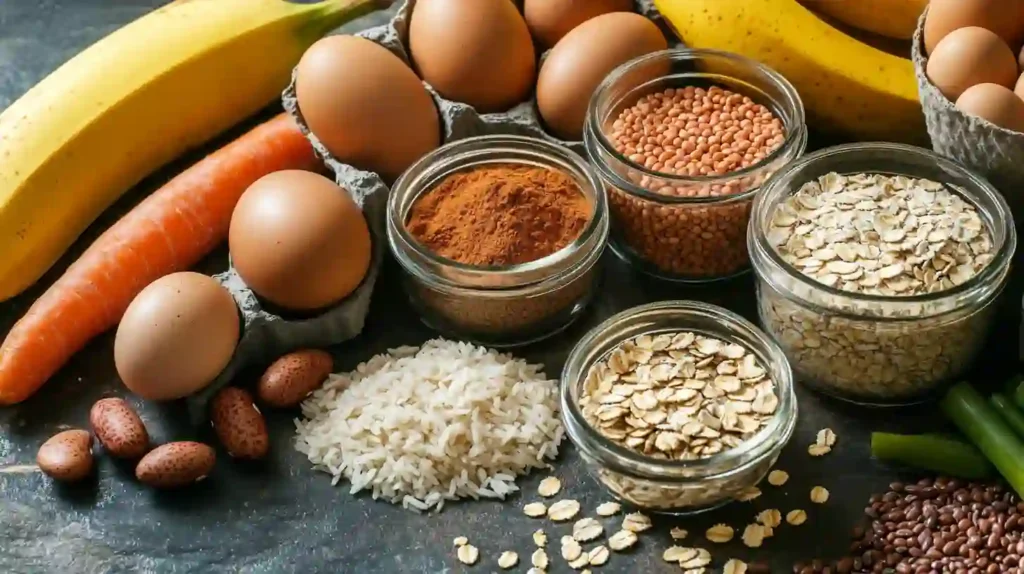
You just need to focus on smart, multi-use foods that stretch across several meals. Here’s how I do it:
1. Choose low-cost protein sources
Proteins don’t have to be expensive. I stock up on:
- Dried lentils
- Canned tuna
- Eggs
- Canned black beans
- These keep well, are versatile, and provide the protein base for countless meals.
2. Stick with affordable vegetables
Instead of specialty produce, I go for options that last long and cost little:
- Frozen spinach
- Carrots
- Cabbage
- Onions
- Frozen mixed vegetables
3. Bulk up with budget-friendly carbs
I choose grains and starches that are inexpensive, filling, and easy to prep in batches:
- Brown rice
- Whole wheat pasta
- Old-fashioned oats
- Corn tortillas
4. Buy simple fruits that go the distance
To keep things fresh and sweet without going over budget, I add:
- Bananas
- Apples
- Frozen berries (great for smoothies or oatmeal)
5. Use pantry staples to build flavor
The right basics make budget meals taste great. I always keep on hand:
- Peanut butter
- Canned tomatoes
- Olive oil
- Garlic
- A few key spices (like cumin, paprika, chili powder)
This five-part budget-friendly meal prep grocery list keeps me on track with healthy meals all week long. Whether I’m building inexpensive meal plans or sticking to an easy weekly meal plan, this structure gives me everything I need, without spending more than I have to.
How I Stuck to a $50 Meal Prep Grocery List for the Entire Week
I stuck to a $50 meal prep grocery list by planning simple meals, buying in bulk, choosing affordable proteins like eggs and beans, and shopping store brands. I focused on versatile ingredients, limited snacks, avoided waste, and cooked in batches to stretch my budget for the entire week.
First, sticking to a $50 meal prep grocery list for the entire week was a challenge I took on to cut spending without sacrificing quality. I started by planning a simple weekly meal plan using budget-friendly staples like rice, beans, oats, eggs, and frozen vegetables. Every item on my list had to serve more than one meal no extras, no waste.
Finally i avoided expensive cuts of meat, skipped pre-made snacks, and relied on homemade meals that I could batch cook. I also focused on seasonal produce and store-brand items to stretch every dollar. By midweek, I realized that I wasn’t just saving money I was eating better, wasting less, and spending zero time wondering what to cook.
Tips for Smarter Grocery Shopping
When it comes to making the most of your meal prep grocery list, how you shop is just as important as what you buy. Over the years, I’ve learned a few key strategies that make my grocery trips faster and meal prep cheaper, and far more efficient. These small habits have helped me follow my weekly meal plans more consistently and stick to my budget without sacrificing variety or quality.
1. Shop with a purpose
Never enter the store without a clear meal prep grocery list. I base mine on the week’s meal plan, so I only buy what I need nothing more, nothing less.
2. Organize your list by store layout
I group items by sections: produce, dairy, pantry, frozen, etc. This saves time and prevents me from circling back or grabbing impulse items.
3. Buy in bulk when it makes sense
For ingredients I use regularly, like oats, rice, or canned beans I buy larger quantities to cut costs and reduce the number of trips.
4. Use what you already have first
Before I write my list, I scan my fridge and pantry. This helps me build a budget-friendly meal prep grocery list around ingredients I already own.
5. Don’t shop hungry
It sounds simple, but shopping while hungry always leads me to buy more snacks and fewer essentials. A quick snack before the store keeps me focused.
6. Stick to seasonal produce
Seasonal fruits and vegetables are fresher, cheaper, and taste better. I rotate my weekly choices based on what’s in season, which also brings variety to my easy weekly meal plan.
7. Check unit prices
Instead of just looking at the price tag, I compare the cost per ounce or per pound. This has helped me make smarter decisions, especially for pantry staples.
These habits don’t take much time, but they completely change how effective my grocery list for meal prep becomes. The more intentional I am with my shopping, the easier the rest of the week feels from cooking to staying on track with my meals.
FAQ
What is the 5 4 3 2 1 grocery rule?
It’s a simple formula: 5 vegetables, 4 fruits, 3 proteins, 2 grains, and 1 healthy fat to build a balanced meal prep grocery list.
How to meal plan a grocery list?
Plan your meals first, list the ingredients, group them by category, and check what you already have. Then write your meal prep grocery list from what’s missing.
How long does food stay good for meal prep?
Most meals last 3–5 days in the fridge. Freeze anything you won’t eat in that time to avoid waste.
What are the downsides of meal prepping?
It can be time-consuming, repetitive, and food may spoil if not stored properly. Variety and planning help reduce these issues.
Conclusion
Creating a solid meal prep grocery list has completely transformed the way I plan, shop, and eat. Whether I’m aiming to eat healthier, lose weight, save money, or simply reduce daily stress, having a reliable list keeps me consistent and on track. From organizing weekly meals to cutting down waste and impulse buys, the right grocery list does more than simplify it empowers smarter, more intentional eating.
No matter your goal, there’s a version of a meal prep grocery list that fits your lifestyle from clean eating to budget friendly meal plans or even meal prep for weight loss grocery list strategies. Use the templates, tips, and examples in this guide as a starting point, and adjust them to what works best for you. The more prepared you are before you shop, the easier it becomes to stick to your goals all week long.
